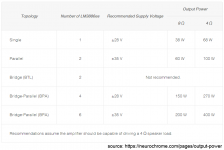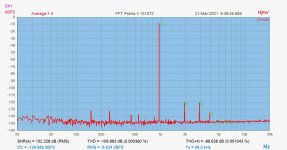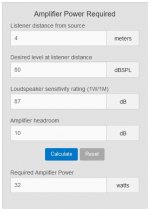If you really need 150W RMS then the LM3886 is really not the amp of choice.
You'd be better with a discrete BJT or Mos-Fet amp.
A single LM3886 is only really suitable for 36W into 8R. If you bridge it it can produce 100W into 4R, possibly a bit more.
Above 50W you should be looking at good Class AB designs.
There are Class D designs that are good but I wouldn't recommend any of them.
You'd be better with a discrete BJT or Mos-Fet amp.
A single LM3886 is only really suitable for 36W into 8R. If you bridge it it can produce 100W into 4R, possibly a bit more.
Above 50W you should be looking at good Class AB designs.
There are Class D designs that are good but I wouldn't recommend any of them.
I think either LM3886 or a discrete transistor-based amplifier can sound great. Reaching 150 W with a LM3886 will require some careful paralleling of devices. I have projects for both types of amplifiers:
GitHub - profdc9/SuperGainClone: A stereo layout of Bob Cordell's Super Gain Clone amplifier.
GitHub - profdc9/PowerAmpAudio: Power Amplifier based on Michael Chua's C300 amplifier
If you have not built an amplifier before, a LM3886 is definitely an easier choice to start with. 150 W is a lot of power and perhaps you may consider whether or not a lower amount of power will satisfy your needs.
GitHub - profdc9/SuperGainClone: A stereo layout of Bob Cordell's Super Gain Clone amplifier.
GitHub - profdc9/PowerAmpAudio: Power Amplifier based on Michael Chua's C300 amplifier
If you have not built an amplifier before, a LM3886 is definitely an easier choice to start with. 150 W is a lot of power and perhaps you may consider whether or not a lower amount of power will satisfy your needs.
Last edited:
regarding the maximum power of different LM3886 configurations have a look at the excellent "taming the 3886" page by neurochrome:
Taming the LM3886 Chip Amplifier: Output Power – Neurochrome
short answer below.
discrete amps will have similar (or less) output at a given supply voltage.
your transformers (25 V AC) will produce about 33 V rectified. so you will have to go for a bridged amp to get 150W, unless you have 2 ohm speakers 😀
Taming the LM3886 Chip Amplifier: Output Power – Neurochrome
short answer below.
discrete amps will have similar (or less) output at a given supply voltage.
your transformers (25 V AC) will produce about 33 V rectified. so you will have to go for a bridged amp to get 150W, unless you have 2 ohm speakers 😀
Attachments
the 3 lm3886 parallel amp will not give you 150w/ 4 ohms. Maybe 120, and maybe 75w/8ohms.Only decision have to take LM3886X3 parallel per channel or any Bipolar Transistor Circuit
You could stack up the windings of the 4 25 v transformers to make +-33 v on two channels, which is beginning to be capable of 150 w. However at 250 va you'll have trouble getting the wattage rms. Class AB you can only get about 1/2 of transformer wattage on the speaker. Rest comes out on the heat sink. You would have to rely on your huge capacitors to supply peak wattage.
For a list of proven bipolar transistor amplifiers check out: A Directory of Apex Audio Amplifiers
For 4 amp peaks on 4 ohm speakers you would need at least 4 output pairs of wimpy 2sa1943/2sc5200.
You playing a party outdoors or something? In my house 70W through a 101 db 1w1m speaker is loud enough for me. Of course lower sensitivity speakers are watt consumers.
For a list of proven bipolar transistor amplifiers check out: A Directory of Apex Audio Amplifiers
For 4 amp peaks on 4 ohm speakers you would need at least 4 output pairs of wimpy 2sa1943/2sc5200.
You playing a party outdoors or something? In my house 70W through a 101 db 1w1m speaker is loud enough for me. Of course lower sensitivity speakers are watt consumers.
Last edited:
One can bring out quite some watts, from a parallel - bridged lm3886 configuration.
Attached is a 2* 3parallel//bridged lm3886 amp, +_35V rails, 2* dual 25Vrms sec., 300VA (each) trafos, output is taken by RTX6001, 36,15Vrms on 7ohm load (186W).
Attached is a 2* 3parallel//bridged lm3886 amp, +_35V rails, 2* dual 25Vrms sec., 300VA (each) trafos, output is taken by RTX6001, 36,15Vrms on 7ohm load (186W).
Attachments
How much amplifier power do you need?
You can calculate approximate power requirements for your specific needs: Crown Audio - Professional Power Amplifiers
One of the important parameter here is the speaker sensitivity.
You can calculate approximate power requirements for your specific needs: Crown Audio - Professional Power Amplifiers
One of the important parameter here is the speaker sensitivity.
Attachments
Ok sirYou will get + -35V supply voltage with no load. 3886 will give 50 watts into an 8 ohm load according to the datasheet. Parallel connection will not increase the power in the load. You will need a bridge connection and in each arm you need to connect 2 ICs in parallel for a total of 4 ICs per channel.
This also applies to BJT, especially Mosfet.
Got it ThanksIf you really need 150W RMS then the LM3886 is really not the amp of choice.
You'd be better with a discrete BJT or Mos-Fet amp.
A single LM3886 is only really suitable for 36W into 8R. If you bridge it it can produce 100W into 4R, possibly a bit more.
Above 50W you should be looking at good Class AB designs.
There are Class D designs that are good but I wouldn't recommend any of them.
Thanks a lot Actually I want full 40 Watt clean so I decide for 150 Watt so I can get clean 40 Watt that my assumption ....I think either LM3886 or a discrete transistor-based amplifier can sound great. Reaching 150 W with a LM3886 will require some careful paralleling of devices. I have projects for both types of amplifiers:
GitHub - profdc9/SuperGainClone: A stereo layout of Bob Cordell's Super Gain Clone amplifier.
GitHub - profdc9/PowerAmpAudio: Power Amplifier based on Michael Chua's C300 amplifier
If you have not built an amplifier before, a LM3886 is definitely an easier choice to start with. 150 W is a lot of power and perhaps you may consider whether or not a lower amount of power will satisfy your needs.
Thanks a lotregarding the maximum power of different LM3886 configurations have a look at the excellent "taming the 3886" page by neurochrome:
Taming the LM3886 Chip Amplifier: Output Power – Neurochrome
short answer below.
discrete amps will have similar (or less) output at a given supply voltage.
your transformers (25 V AC) will produce about 33 V rectified. so you will have to go for a bridged amp to get 150W, unless you have 2 ohm speakers 😀
Thanks a lotYou can calculate approximate power requirements for your specific needs: Crown Audio - Professional Power Amplifiers
One of the important parameter here is the speaker sensitivity.
- Home
- Amplifiers
- Solid State
- LM3886 or Bipolar Transistor


